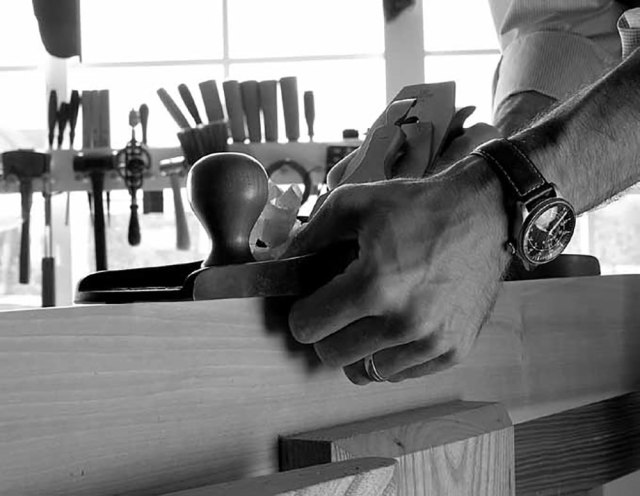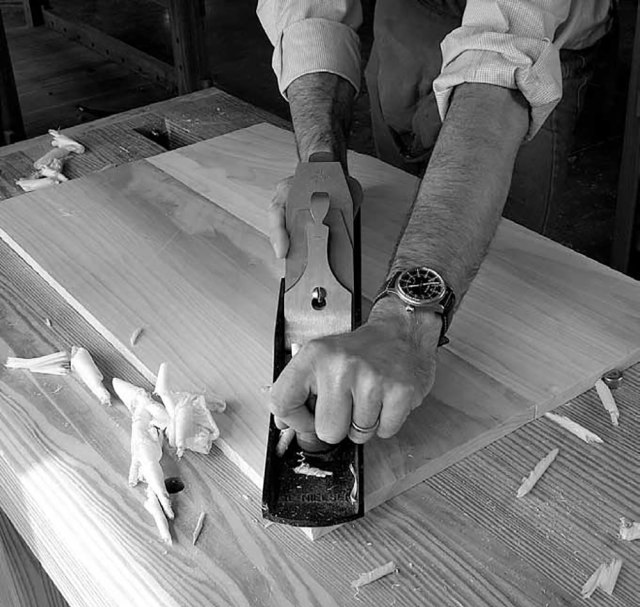
This is an excerpt from “The Art of Joinery” by Joseph Moxon; commentary by Christopher Schwarz.
The jointer is made somewhat longer than the fore plane and has its sole perfectly straight from end to end. Its office is to follow the fore plane and to shoot an edge perfectly straight, and not only an edge, but also a board of any thickness; especially when a joint is to be shet [shot]. Therefore the hand must be carried along the whole length with an equal bearing weight, and [al]so exactly even and upright to the edges of the board, [so] that neither side of the plane inclines either inward or outwards, but that the whole breadth be exactly square on both its sides. Supposing its sides straight, [then] so will two edges of two boards, when thus shot, lie so exactly flat and square upon one another that light will not be discerned between them. It is counted a piece of good workmanship in a joiner to have the craft of bearing his hand so curiously [in this way], even the whole length of a long board. And yet it is but a sleight [task] to those [where] practice hath accustomed the hand to [it]. The jointer is also used to try tabletops with {large or small}, or other such broad work. And then joiners work as well upon the traverse with it, as with the grain of the wood, and also angularly or corner-wise, that they may be more assured of the flatness of their work.
Its iron must be set very fine, so fine, that when you wink with [close] one eye, and [look at the iron with your open] eye, there appears a little above a hairs breadth of the edge above the surfaces of the sole of the plane, and the length of the edge must lie perfectly straight with the flat breadth of the sole of the plane. [With] the iron being then well wedged up and you working with the plane thus set, [you] have the greater assurance that the iron cannot run too deep into the stuff; and consequently you have the less danger that the joint is wrought out of straight.

Analysis
In Moxon, the primary job of the jointer plane seems to be working edges to make them straight and true. Not only to make them pretty but to glue them up into panels.
Now here is one area where Moxon vexes me. Moxon calls for the jointer plane to have an iron that is sharpened perfectly straight across, like a chisel. And the way you correct an edge is through skill – Moxon says it looks hard to the layman but is easy for joiners.
As one who has practiced freehand edge-planing with a jointer plane that has a straight-sharpened iron, I object. I think it’s easier to correct an edge with an iron with a slight curve. You can remove material from localized spots by positioning the iron to take more meat off one area.
This jointing technique with a curved iron appears in British workshop practice throughout the 20th century. It is today a fight as fierce as tails-first or pins-first in dovetailing. So give both jointing techniques a try and take your side. And just be glad Moxon doesn’t write a word about dovetailing.
One note here on long-grain shooting boards. Moxon doesn’t mention them, though they are frequently mentioned and employed starting in the 18th century. When you use a jointer plane with a shooting board to true an edge of a board, the iron of the jointer plane can be either curved or straight.
Both approaches work.
Several of my contemporary hand-tool woodworkers have suggested that perhaps Moxon simply could not see that the jointer plane’s iron is slightly curved. And indeed, the curve used on the edge of a jointer plane’s iron looks straight if you don’t show it to a second piece of straight material. However, I prefer to simply take Moxon at his word here. The joiners he observed use jointers with straight irons.

Other jointer techniques in Moxon are quite helpful. He says you can traverse with a jointer and that you can work diagonally (corner to corner) across the grain with wide stock. Both of these techniques help flatten your boards because the jointer’s sole is removing high spots at the corners, which is commonly known as “twist” or “wind.” Note that Moxon says joiners use this for tabletops or other boards that are quite broad.
Other period accounts discuss other long planes. Richard Neve’s “The City and Country Purchaser” (1703) calls out two long planes: “The Long Plane,” which is about 24″ long, for faces of boards; and the jointer plane, which is about 30″ long, for edge joints.
Moxon’s instructions for setting a jointer plane can be interpreted as follows: Turn the plane over and sight down the sole. Close one eye. Peer down the sole and adjust the iron until you see it as a fine black line (about the thickness of a hair) that is even all across the width of the sole. That’s a good description of what it looks like. To my (one) eye, a hair’s breadth usually gets me a shaving that’s about .004″ to .006″ thick.
— MB